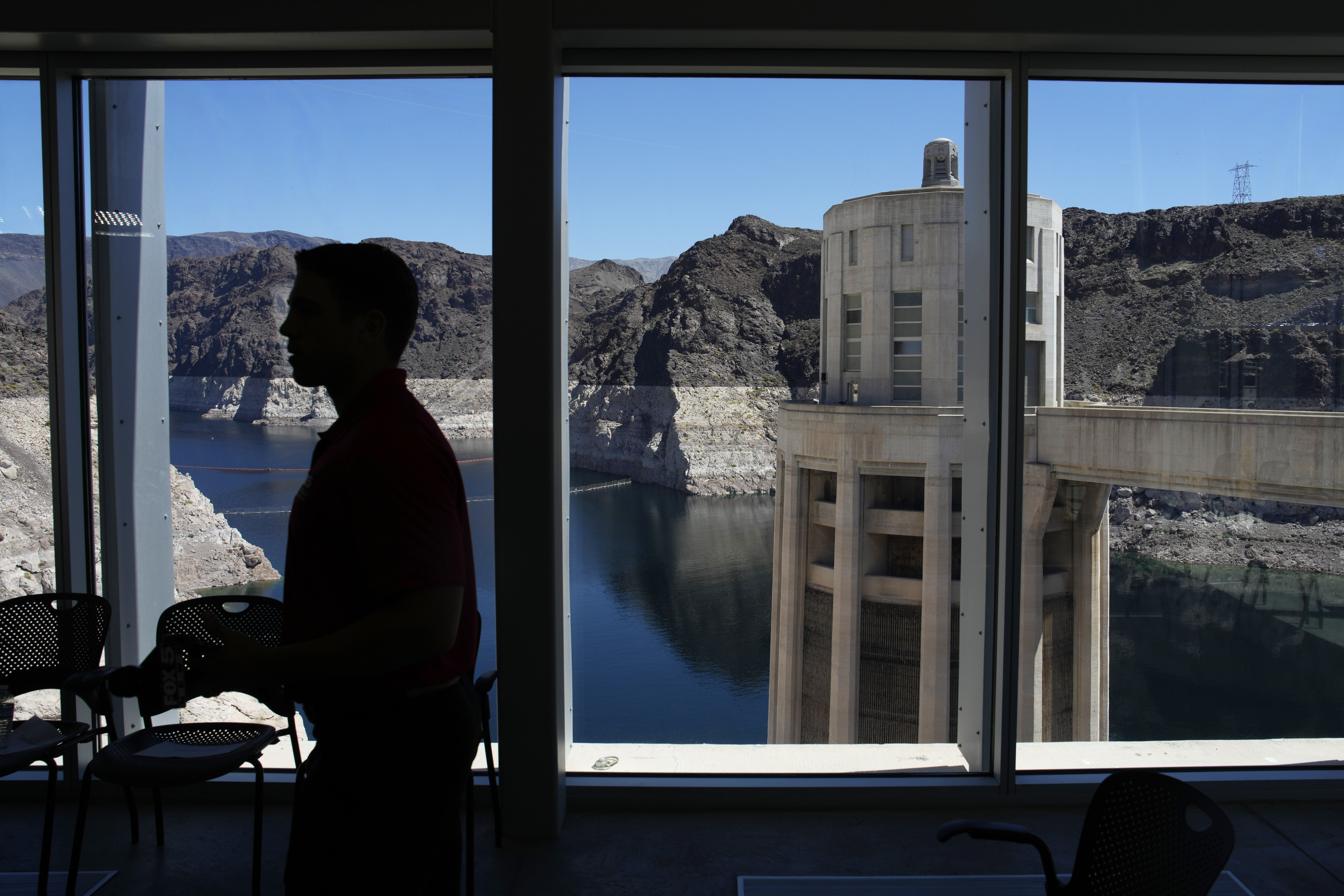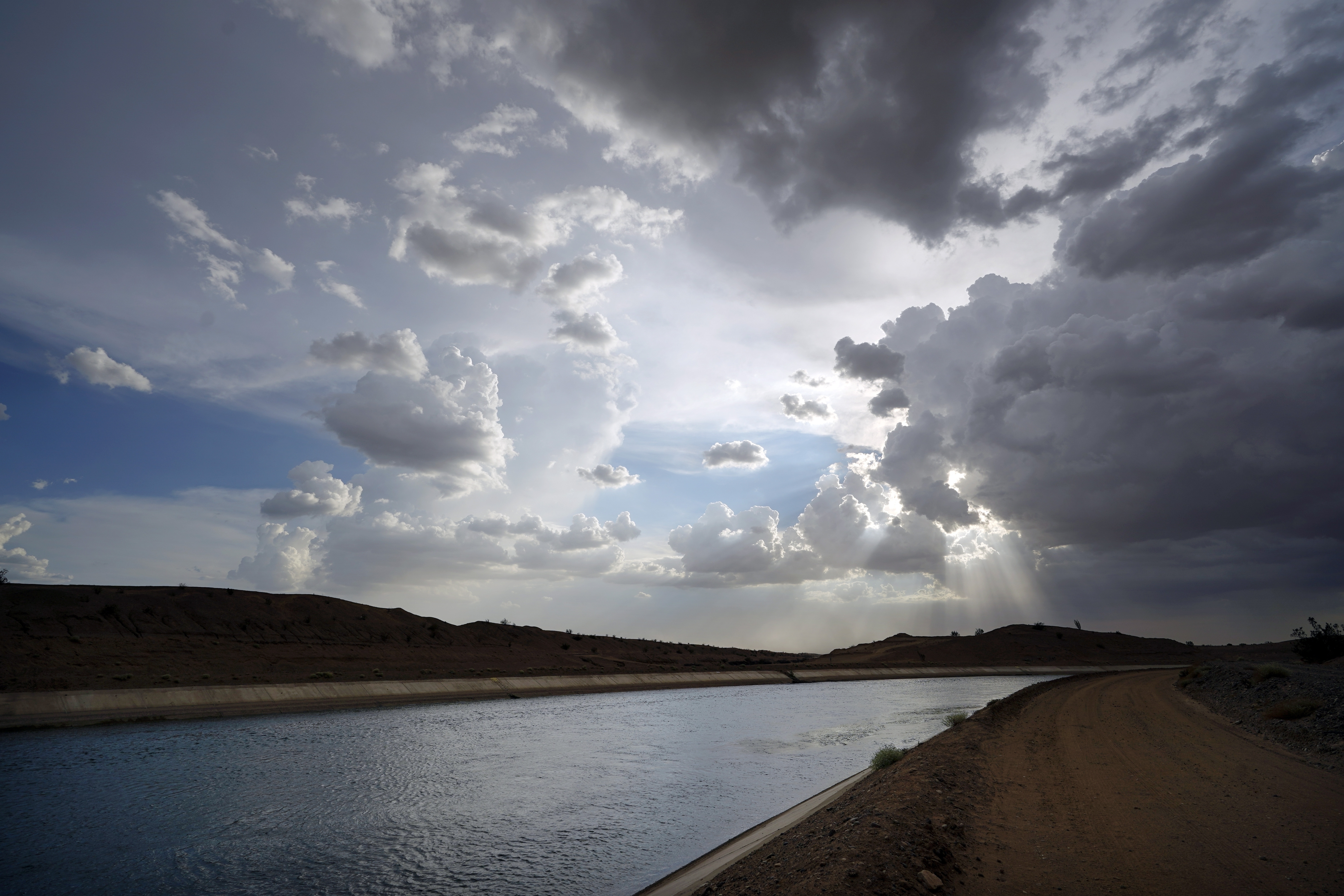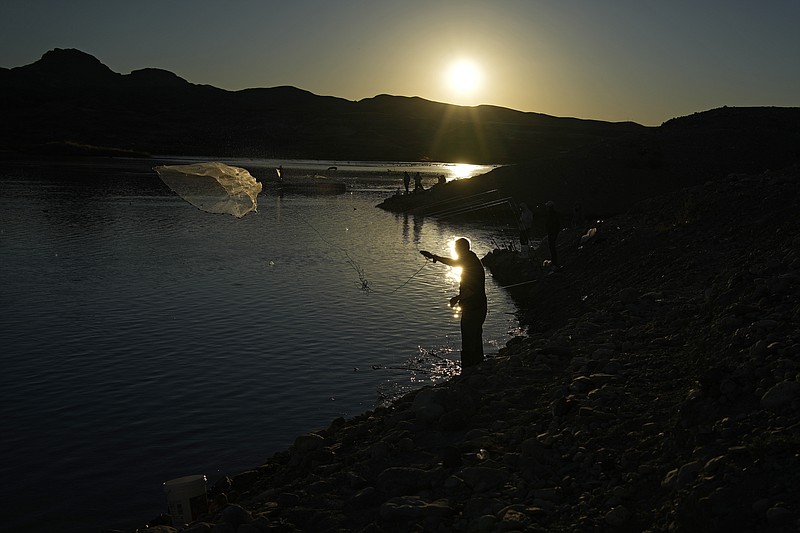LAS VEGAS -- Arizona, Nevada and California said Monday that they're willing to cut back on their use of the dwindling Colorado River in exchange for money from the federal government -- and to avoid forced cuts as drought threatens the key water supply for the U.S. West.
To stabilize the river, the three states the Lower Basin comprises -- California, Arizona and Nevada -- have agreed to voluntarily conserve 3 million acre-feet of water over the next three years, which amounts to 13% of these states' total allocation from the river. The Biden administration has committed to compensating the states for three-quarters of the water savings -- or 2.3 million acre-feet -- which would amount to some $1.2 billion in federal funds, the people familiar with the talks said.
The money from the Inflation Reduction Act would pay farmers, Native American tribes, cities and others who voluntarily forgo their supplies.
"There are 40 million people, seven states, and 30 Tribal Nations who rely on the Colorado River Basin for basic services such as drinking water and electricity," Interior Secretary Deb Haaland said in a statement on Monday. "Today's announcement is a testament to the Biden-Harris administration's commitment to working with states, Tribes and communities throughout the West to find consensus solutions in the face of climate change and sustained drought."
The 1,450-mile river provides water to 40 million people in seven U.S. states, parts of Mexico and more than two dozen Native American tribes. It produces hydropower and supplies water to farms that grow most of the nation's winter vegetables.
Though adoption of the plan isn't certain, U.S. Bureau of Reclamation Commissioner Camille Touton called it an "important step forward." She said the bureau will pull back its proposal from last month that could have resulted in sidestepping the existing water priority system to force cuts while it analyzes the three-state plan. The bureau's earlier proposal, if adopted, could have led to a messy legal battle.
Last summer, the U.S. Bureau of Reclamation called for the seven basin states to figure out how to cut their collective use of Colorado River water by about 2 to 4 million acre feet in 2023 alone -- roughly 15% to 30% of their annual use -- but states blew past that deadline and an agreement remained elusive for several more months.
In April, the U.S. Bureau of Reclamation released a plan that considered two ways to force cuts for Arizona, Nevada and California. One contemplated using a decades-old water priority system that would have benefited California and some Native American tribes with senior water rights. The other would have been a percentage cut across the board.
The last time the seven states of the Colorado River basin had negotiated cutbacks in their usage, it had taken nearly six years. This time, Touton gave the states two months to reach a deal.
That launched an intense negotiation that blew through two deadlines and at times involved bitter disputes between the parties. One central tension was between Arizona and California, the two states that pull the most from Lake Mead. If the cutbacks in water use followed the legal priority system, Arizona would be hit hard, risking the water supply to Phoenix and Tucson. If the states deviated from the priority system and distributed cuts equally among the Lower Basin, California and its powerful farming regions, such as the Imperial Valley, stood to take a major blow.
"At least they're still talking. But money helps you keep talking," said Terry Fulp, former regional director of the U.S. Bureau of Reclamation's Lower Colorado Basin region. He noted the agreement is a "short-term, three-year deal" and that because the Upper Basin states of Colorado, New Mexico, Utah, and Wyoming didn't face immediate cuts, they were not part of the pact.
The three Lower Basin states are entitled to a total of 7.5 million acre-feet of water from the river. An acre-foot of water is roughly enough to serve two to three U.S. households annually.
California gets the most, based on a century-old water rights priority system. Most of that goes to farmers in the Imperial Irrigation District, though some also goes to smaller water districts and cities across Southern California. Arizona and Nevada have already faced cuts in recent years as key reservoir levels dropped, based on prior agreements. But California has been spared.
Under the new proposal, California would give up about 1.6 million acre-feet of water through 2026 -- a little more than half of the total. That's roughly the same amount the state first offered six months ago. It wasn't clear why the other states agreed to a deal now when California didn't offer further cuts. Leaders in Arizona and Nevada didn't immediately say how they'd divide the other 1.4 million acre-feet.
CONSERVATION PLANS
Arizona, California and Nevada are still finalizing where all these water savings will come from within their states, but some of the outlines have emerged. California plans to contribute 1.6 million of the 3 million acre-feet over three years, according to a statement by the Colorado River Board of California. California is the largest user of the Colorado River, with an allocation of 4.4 million acre-feet per year.
"California's water users will work quickly to implement conservation that will protect the system in the near term," J.B. Hamby, the chairman of the Colorado River Board of California, said in a statement.
Nevada has pledged to conserve 285,000 acre-feet through 2026, according to John Entsminger, the Southern Nevada Water Authority General Manager and state's commissioner to the negotiations.
Entsminger said this amount would be saved in Lake Mead and would be uncompensated by the federal government. That's because Nevada, which has a small allocation of 300,000 acre-feet per year from the river, wants to preserve the chance of getting some of that water back post-2027.
"For the state with a legal entitlement to 1.8% of the river, the water is more valuable to us than the federal money," Entsminger said in an interview, adding that "there's very solid comfort that this is going to be implemented."
The Imperial Irrigation District would account for more than half of California's cuts. Hamby said the district has already taken measures to improve water efficiency and will need to do more. He said the district is working on a pilot summer idling program where farmers would sign up to turn off their water for 60 days for forage crops. During that time of year, yields are already down and more water is required, he said.
Bill Hasencamp, manager of Colorado River resources for the Metropolitan Water District of California, which supplies water to 19 million people in southern California, said the wet winter means the state simply needs less water. His district is planning on leaving 250,000 acre-feet this year in Lake Mead, and won't withdraw it until after 2026.
The district will also turn over to the federal government a program that pays farmers to fallow land that typically nets them about 130,000 acre-feet of water a year, he said. Metropolitan will save roughly $100 million over three years, he said.
Tom Buschatzke, director of the Arizona Department of Water Resources, stressed that the announcement is not a final deal.
"We agreed to a proposal. This is not an agreement," Buschatzke said during a conference call with reporters. Buschatzke said the proposal still needs analysis and approval from the federal government, which will determine how much funding will be allocated for entities that give up water.
Buschatzke would not specify how much water savings would come from Arizona.
Arizona Gov. Katie Hobbs said the deal provided a way to "build our reservoirs back up in the near-term," but added that work remained to address long-term effects of climate change and overallocation. Govs. Gavin Newsom of California and Joe Lombardo of Nevada also praised the agreement.
Becky Mitchell, director of the Colorado Water Conservation Board, said on Monday that Upper Basin states didn't have a chance to analyze Arizona, Nevada and California's plan in detail. The plan doesn't change how much water the Upper Basin states of Colorado, New Mexico, Utah or Wyoming will receive.
"The wet winter has given us a bit of space to negotiate, but we must not squander this gift from Mother Nature," Mitchell said. She said Colorado and other basin states urged federal officials to return to longer-term discussions about how to preserve water levels at Lakes Mead and Powell beyond 2026.
Colorado Democratic U.S. Sen. John Hickenlooper called the plan "a hopeful step towards avoiding catastrophe." He pointed toward Bureau of Reclamation analysis of the plan "with hopes this provides a path to a seven-state agreement."
The Colorado River has been in crisis for years due to a multi-decade drought in the West intensified by climate change, rising demand and overuse. Water levels at key reservoirs dipped to unprecedented lows, though they have rebounded somewhat thanks to heavy precipitation this winter.
In recent years the federal government has cut some water allocations and offered billions of dollars to pay farmers, cities and others to cut back. But key water officials didn't see those efforts as enough to prevent the system from collapsing.
Michael Cohen, a senior researcher at the Pacific Institute focused on the Colorado River, called the amount of cuts the three states have proposed a "huge, huge lift" and a significant step forward.
"It does buy us a little additional time," he said. But if more dry years are ahead, "this agreement will not solve that problem."
Hasencamp said the agreement could provide a few years of stability for Los Angeles, San Diego and other California cities that rely on water from the Colorado.
The greater challenge will be reaching a deal after 2026, when the federal government may not be willing to provide as much funding to conserve water, and states won't be able to count on more winters of heavy rain and snowfall. "We know that the future is going to be drier than the past," Hasencamp said.
The deal is also a victory of sorts for the Biden administration, which has at times appeared unsure how to respond to the growing crisis. In the past year, it twice set deadlines for the states to come to an agreement, which they failed to meet. The Interior Department said the agreement shows that states are able to work together with the federal government to address the challenge of the Colorado's decline.
That notion, too, will soon be tested. The Interior Department has said its next step will be to study the effects of the deal that states have struck, before deciding how to proceed. In the meantime, the next round of negotiations, about what to do after 2026, are set to begin next month.
Information for this article was contributed by Suman Naishadam, Ken Ritter and Amy Taxin of The Associated Press, by Joshua Partlow of The Washington Post and by Christopher Flavelle of The New York Times.
 FILE - People attend a news conference on Lake Mead at Hoover Dam, April 11, 2023, near Boulder City, Nev. Arizona, California and Nevada on Monday, May 22, proposed a deal to significantly cut their water use from the drought-stricken Colorado River over the next three years. (AP Photo/John Locher, File)
FILE - People attend a news conference on Lake Mead at Hoover Dam, April 11, 2023, near Boulder City, Nev. Arizona, California and Nevada on Monday, May 22, proposed a deal to significantly cut their water use from the drought-stricken Colorado River over the next three years. (AP Photo/John Locher, File) FILE - Water flows along the All-American Canal, Aug. 13, 2022, near Winterhaven, Calif. The canal conveys water from the Colorado River into the Imperial Valley. Arizona, California and Nevada on Monday, May 22, proposed a deal to significantly cut their water use from the drought-stricken Colorado River over the next three years. (AP Photo/Gregory Bull, File)
FILE - Water flows along the All-American Canal, Aug. 13, 2022, near Winterhaven, Calif. The canal conveys water from the Colorado River into the Imperial Valley. Arizona, California and Nevada on Monday, May 22, proposed a deal to significantly cut their water use from the drought-stricken Colorado River over the next three years. (AP Photo/Gregory Bull, File)